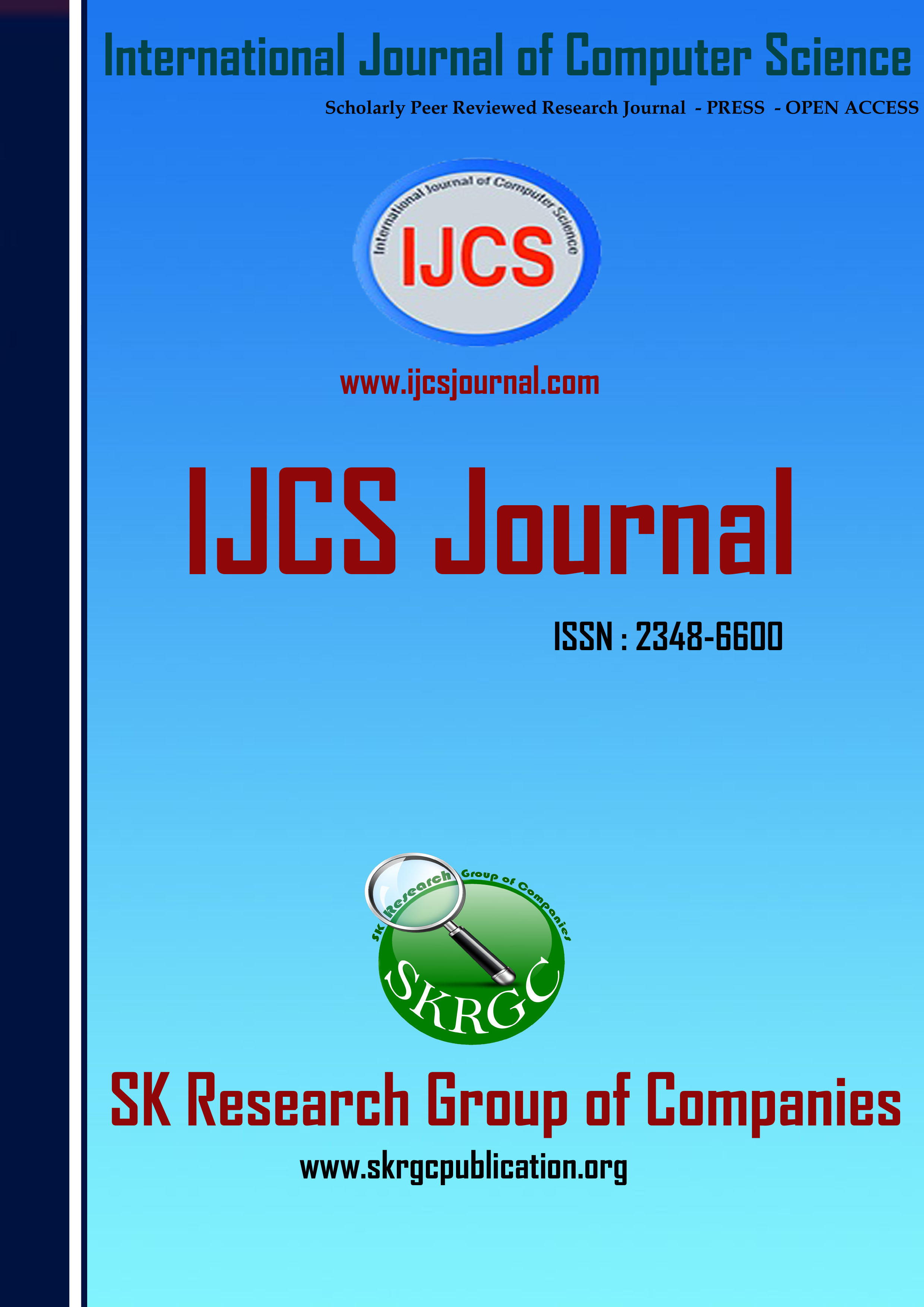An Improved Genetic Algorithm Based Weight Optimized RBF Kernel System for Face Recognition
International Journal of Computer Science (IJCS) Published by SK Research Group of Companies (SKRGC)
Download this PDF format
Abstract
Face recognition system is one of many biometric authentication systems which are used for authentication purpose. It provides an effective way for authentication with varied security features. Management of high dimension data is problem which arrives frequently in face recognition. In this paper a new method is proposed for biometric authentication based face recognition which is general and efficient approach using radial basis function (RBF) kernel to manage small training sets of high dimension. In order to avoid over fitting and reduce the computational complexity, face features are first extracted by the singular value decomposition (SVD) method. After that resulting features were further processed by the Fisher’s linear discriminate (FLD) technique to acquire lower-dimensional discriminate features. Data mining techniques have been widely used in intruder detection decision support systems to obtain good accuracy. A fast learning genetic algorithm (GA) is used to train the RBF kernels so that the aspects of the search space are significantly reduced. Results will be obtained after conducting simulations on ORL database, which are more precise in classification and learning efficiency
References
[1]R. Chellappa, C. L. Wilson, and S. Sirohey, “Human and machine recognition of faces: A survey,”Proc. IEEE, vol. 83, pp. 705–740,1995.
[2]Y. Moses, Y. Adini, and S. Ullman, “Face recognition: The problem of compensating for changes in illumination direction,” in Proc. EuroP.Conf. Comput. Vision, vol. A, 1994, pp. 286–296.
[3]R. Brunelli and T. Poggio, “Face recognition: Features versus templates,”IEEE Trans. Pattern Anal. Machine Intell., vol. 15, pp.1042–1053, 1993.
[4]P. J. Phillips, “Matching pursuit filters applied to face identification,”IEEE Trans. Image Processing, vol. 7, pp.1150–1164, 1998.
[5]Z. Hong, “Algebraic feature extraction of image for recognition,”Pattern Recognition, vol. 24, pp. 211–219, 1991.
[6]M.A.TurkandA.P.Pentland,“Eigen faces for recognition,”J.Cognitive Neurosci., vol. 3, pp. 71–86, 1991.
[7]P. N. Belhumeur, J. P. Hespanha, and D.J. Kriegman, “Eigenfaces versus fisherfaces: Recognition using class specific linear projection,” IEEE Trans. Pattern Anal. Machine Intell., vol. 19, pp. 711–720,1997.
[8]D. L. Swets and J. Weng, “Using discriminant eigenfeatures for image retrieval,”IEEETrans. Pattern Anal. Machine Intell., vol. 18, pp.831–836, 1996.
[9]D. Valentin, H. Abdi, A. J. O’Toole, and G. W. Cottrell,“Connectionist models of face processing: A Survey,” Pattern Recognition, vol. 27, pp. 1209–1230, 1994.
[10]J. Mao and A. K. Jain, “Artificial neural networks for feature extraction and multivariate data projection,”IEEE Trans. Neural Networks, vol. 6, pp. 296–317, Mar. 1995.
[11]S. Lawrence, C. L. Giles, A. C. Tsoi, and A. D. Back, “Face recognition: A convolutional neural-network approach,”IEEE Trans.Neural Networks, vol. 8, pp. 98–113, Jan. 1997.
[12]S.-H. Lin, S.-Y. Kung, and L.-J. Lin, “Face recognition/detection by probabilistic decision-based neural network,”IEEE Trans. Neural Networks, vol. 8, pp. 114–132, Jan. 1997.
[13]K. Fukunaga,Introduction to Statistical Pattern Recognition, 2nd ed.San Diego, CA: Academic Press, 1990.
[14]H. H. Song and S. W. Lee, “A self-organizing neural tree for large-set pattern classification,”IEEE Trans. Neural Networks, vol. 9, pp. 369–380, Mar. 1998.
[15]C. M. Bishop,Neural Networks for Pattern Recognition, New York:Oxford Univ. Press.
[16]J. L. Yuan and T. L. Fine, “Neural-Network design for small training sets of high dimension,”IEEE Trans. Neural Networks, vol. 9, pp.266–280, Jan. 1998.
[17]J. Park and J. Wsandberg, “Universal approximation using radial basis functions network,”Neural Comput., vol. 3, pp. 246–257, 1991.
[18]F. Girosi and T. Poggio, “Networks and the best approximation property,”Biol. Cybern., vol. 63, pp. 169–176, 1990.
[19]J. Moody and C. J. Darken, “Fast learning in network of locally-tuned processing units,”Neural Comput., vol. 1, pp. 281–294, 1989.
[20]S. Lee and R. M. Kil, “A Gaussian potential function network with hierarchically self-organizing learning,”Neural Networks,vol. 4, pp.207–224, 1991.
[21]W. Pedrycz, “Conditional fuzzy clustering in the design of radial basis function neural networks,”IEEE Trans. Neural Networks, vol. 9, pp.601–612, July 1998.
[22]M. T. Musavi, W. Ahmed, K. H. Chan, K. B. Faris, and D. M.Hummels,“On the training of radial basis function classifiers,”Neural Networks, vol. 5, pp. 595–603, 1992.
[23]S. Chen, C. F. N. Cowan, and P. M. Grant, “Orthogonal least squares learning algorithm for radial basis function network,”IEEE TransNeural Networks, vol.2, pp. 302–309, 1991
[24]G. Bors and M. Gabbouj, “Minimal topology for a radial basis functions neural networks for pattern classification,”Digital Processing, vol. 4, pp. 173–188, 1994.
[25]S. Wu and M. J. Er, “Dynamic fuzzy neural networks: A novel approach to function approximation,”IEEE Trans. Syst, Man, Cybern,pt. B: Cybern, vol. 30, pp. 358–364, 2000.
[26]A. G. Bors and I. Pitas, “Median radial basis function neural network,”IEEE Trans. Neural Networks, vol. 7, pp. 1351–1364, Sept. 1996.
[27]N. B. Karayiannis and G. W. Mi, “Growing radial basis neuralnetworks: Merging supervised and unsupervised learning with network growth techniques,”IEEE Trans. Neural Networks, vol. 8, pp. 1492–1506, Nov. 1997.
[28]A. Esposito, M. Marinaro, D. Oricchio, and S. Scarpetta,“Approximation of continuous and discontinuous mappings by agrowing neural RBF-based algorithm,”Neural Networks, vol. 12, pp.651–665, 2000.
[29]E.-D. Virginia, “Biometric identification system using a radial basis network,” in Proc 34th Annu. IEEE Int. Carnahan Conf. Security Technol., 2000, pp. 47–51.
Keywords
RBF Kernels; Face Recognition System; Optimization; Genetic Algorithm

